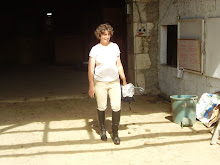The method I use is called TPRS, Teaching Proficiency through Reading and Storytelling. It grew out of TPR, Total Physical Response, which you've probably heard of. You give orders to beginning students, Stand up! Sit down! Clap your hands! Turn around! And in no time at all they are understanding and acting on a large number of commands. The hard part was where do you go from there? A man named Blaine Ray, who was teaching Spanish in California, found that by making up little stories with his students, he could get them to acquire the language much better than with traditional methods. A group of teachers started using his method and carried it further, using the internet to communicate their experiences. One of the remarkable things about the method is that the internet allowed many different teachers to experiment and give each other feedback in order to enrich and develop their techniques. This is truly a movement that grew from the ground up.
It is still evolving, but all TPRS teachers agree that students learn through Comprehensible Input in the target language and any time spent in class on activities that are not CI is a waste of time (grammar lessons, excercises, drills, etc., etc.) The second element that makes the method effective is Personalization. You talk about the students, you let them make up the stories, which are about them, so they're interested and motivated. I started using it a few years ago, rather timidly at first because I doubted it would work with French students, but as I saw that my students were acquiring what I had thought were "advanced" structures effortlessly, I became convinced that there was something to it. And when I talk to other converts, that seems to be a fairly common pattern: experienced teachers who were considered good teachers became curious, tried it a bit and quickly switched because they could see the difference in the way their students were learning.
It's largely based on the research of Stephen Krachen into how languages are acquired. To put it in a nutshell, traditional "grammar" approaches work with the left brain, analyzing the language, and relies on our short term memory. (Students memorize the vocabulary and memorize the grammar rules.) TPRS works with the right brain and long term memory through constant repetition of the target structures. (Tests are unannounced in order to test what has been acquired rather than what students crammed the night before.)
You can Google Blaine Ray, TPRS, and Ben Slavic to learn more about it. Blaine Ray's site sells what is known as the "Green Bible" which explains all the theory behind it. It's called "Fluency through TPR Storytelling". There are two listserves, where teachers using the method ask for advice, comment on what works and what doesn't work for them, etc., and they have been very helpful to me. The yahoo group http://groups.yahoo.com/group/moretprs/join is the oldest, but they've recently started another one http://www.moretprs.net/ which is easier to navigate. If you're seriously interested, I highly recommend reading Ben Slavic's two books, "TPRS in a Year" and "PQA in a Wink". They helped it all come together for me. PQA means ¨Personalized Questions and Answers" which I found very difficult (asking teenagers personal questions!! Horrors!!) until I read his book and understood how to approach it.
I was able to attend a TPRS workshop in St Louis, and later I went to the National TPRS conference in Minneapolis, met Blaine Ray and Susie Gross and learned some Mandarin. I was able to go to another NTPRS in Chicago in 2010. I organized a school exchange with Lynnette Lang in Wheaton, Illinois, who has been using the method for many years and she did a demonstration for us while she was in Agen. Karen Rowan also came and did a 3 day workshop for us. I was asked to do a workshop in Switzerland by an old friend of mine and it went very well, the teachers there seemed more open than my French colleagues. Or braver. I also did a workshop here in Agen for "La Maison de l'Europe". There were only two participants, but they enjoyed it. I'm convinced that it's far more effective than more traditional methods and gets better results. I've used it with primary students who loved it and I'm now using it with lycée students who were failing in English. It's so rewarding to see them progress with almost every lesson.
